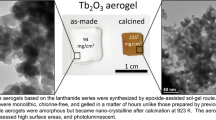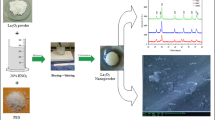Abstract
Lanthanide oxide-based aerogels were synthesized employing the so-called epoxide addition sol–gel method already successfully applied for main- and transition metal oxide aerogels. Using chlorides and nitrates as precursors, our aim was to test the transferability of this robust sol–gel methodology to the entire lanthanide series. By adding the proton scavenging organic epoxide, propylene oxide, to hydrated lanthanide trichloride dissolved in ethanol or methanol, uniform monolithic alcogels were obtained. Subsequent processing in supercritical CO2 resulted in monolithic aerogels. No gelling process could be induced by using nitrates, in contrast to previous results with iron oxide or alumina aerogels. All materials were characterized by nitrogen adsorption/desorption analysis, transmission electron microscopy, and powder X-ray diffraction. With the exception of cerium, for which fractions of crystalline CeO2 were found already in the as-prepared material, XRD analysis revealed that the other materials were mainly amorphous. Subsequent heat treatment of the aerogels above 650 °C resulted in nanocrystalline phases for all aerogel materials. However, except for ceria, more detailed TEM and XRD studies provided evidence that crystalline oxychloride phases are formed in addition to fractions of oxide phases. The trends and possible explanations are discussed in this contribution.
A sol–gel methodology for the preparation of lanthanide-oxide aerogels: synthesis and characterization
A sol–gel methodology using organic epoxides as proton scavengers has been used to synthesize oxide aerogels of the entire lanthanide series. As precursors, nitrates and chlorides were used but only in the latter case, gelation set in. After supercritical drying, aerogels with high surface areas and mesoporous, nanoparticulate structures were obtained. Further characterization revealed that cerium plays a special role, since it contained crystalline CeO2 fractions already before calcination. After calcination it was the only material consisting of a pure oxide phase. The syntheses with the other lanthanides resulted in mixtures with varying fractions of crystalline oxychlorides in addition to an oxide phase. The trends and possible explanations are discussed in this contribution.A sol–gel methodology using organic epoxides as proton scavengers has been used to synthesize oxide aerogels of the entire lanthanide series. As precursors, nitrates and chlorides were used but only in the latter case, gelation set in. After supercritical drying, aerogels with high surface areas and mesoporous, nanoparticulate structures were obtained. Further characterization revealed that cerium plays a special role, since it contained crystalline CeO2 fractions already before calcination. After calcination it was the only material consisting of a pure oxide phase. The syntheses with the other lanthanides resulted in mixtures with varying fractions of crystalline oxychlorides in addition to an oxide phase. The trends and possible explanations are discussed in this contribution.







Similar content being viewed by others
References
Cotton S (1991) Lanthanides and actinides. Oxford University Press, New York
Que W, Kam CH, Zhou Y, Lam YL, Chan YCJ (2001) Appl Phys 90:4865
Garskaite E, Jasaitis D, Kareiva A (2003) J Serb Chem Soc 68:677
Hitz B (2004) In: Photonics spectra, p 112
Mansuy C, Mahiou R, Nedelec JM (2003) Chem Mater 15:3242
Reddy BM, Thrimurthulu G, Katta L, Yamada Y, Park SE (2009) J Phys Chem C 113:15882
Borchert Y, Sonstrom P, Wilhelm M, Borchert H, Baumer M (2008) J Phys Chem C 112:3054
Van der Avert P, Weckhuysen BM (2002) Angew Chem Int Ed 41:4730
Skarman B, Grandjean D, Benfield RE, Hinz A, Andersson A, Wallenberg LR (2002) J Catal 211:119
Sauer J, Marlow F, Spliethoff B, Schuth F (2002) Chem Mater 14:217
Ranjit KT, Cohen H, Willner I, Bossmann S, Braun AM (1999) J Mat Sci 34:5273
Adachi GY, Imanaka N, Tamura S (2002) Chem Rev 102:2405
Wu G, Zhang L, Cheng B, Xie T, Yuan X (2004) J Am Chem Soc 126:5976
Rindone GE (1966) In: Goldberg P (ed) Luminescence of inorganic solids. Academic Press: New York
Li Z, Wu P, Jiang X, Zhang Z, Xu S (1988) J Lumines 40–41:135
Rosenflanz A, Frey M, Endres B, Anderson T, Richards E, Schardt C (2004) Nature 430:761
Zhu B, Liu X, Zhu Z, Ljungberg R (2008) Int J Hydrogen Energy 33:3385
Hierso J, Sel O, Ringuede A, Laberty-Robert C, Bianchi L, Grosso D, Sanchez Cm (2009) Chem Mater 21:2184
In: Ullmann’s encyclopedia of industrial chemistry, 7th edn. Wiley, London (2009)
Eyring L (1979) In: Gschneidner KAJ, Eyring L (eds) Handbook on the physics and chemistry of rare earths, vol 3. North-Holland Physics Publishing: New York, p 337
Eyring L (1991) In: Meyer G, Morss LR (eds) Synthesis of lanthanide and actinde compounds. Kluwer, Dordrecht
Cotton FA, Wilkinson G (1988) Advanced inorganic chemistry, 5th edn. John Wiley and Sons, New York
Shriver DF, Atkins P, Langford CH (1994) Inorganic chemistry, 2nd edn. W. H. Freeman and Company, New York
Rosynek MP (1977) Catal Rev Sci Eng 16:111
Minachev KM, Antoshin GV, Guin NK, Klissurski DG, Abadzhijeva NT (1977) Chem Phys Lett 48:515
Zhang Y, Lei Z, Li J, New S (2001) J Chem 25:1118
Frindell KL, Bartl MH, Popitsch A, Stucky G (2002) D Angew Chem Int Ed 41:960
Skarman B, Nakayama T, Grandjean D, Benfield RE, Olsson E, Niihara K, Wallenberg LR (2002) Chem Mater 14:3686
Pol VG, Palchik O, Gedanken A, Felner I (2002) J Phys Chem B 106:9737
Hungria AB, Martinez-Arias A, Fernandez-Garcia M, Iglesias-Juez A, Guerrero-Ruiz A, Calvino JJ, Conesa JC, Soria J (2003) Chem Mater 15
Wen C, Liu Y, Guo Y, Wang Y, Lu G (1985) Solid State Sci 2009:11
Brinker CJ, Scherer GW (1989) Sol–Gel science: the physics and chemistry of sol-gel processing. Academic Press, San Diego
Thundathil MA, Lai W, Noailles L, Dunn BS, Haile SM (2004) J Am Ceram Soc 87:1442
Rajendran M, Mallick KK, Bhattacharya AK (1998) Mat Lett 37:10
Cardenas GT, Oliva RC (2000) Mater Res Bull 35:2227
Gash AE, Tillotson TM, JHS, Hrubesh LW, Simpson RL (2001) J Non Cryst Solids 285:22
Gash AE, Tillotson TM, JHS, Poco JF, Hrubesh LW, Simpson RL (2001) Chem Mater 13:999
Tillotson TM, Sunderland WE, Thomas IM, Hrubesh LW (1994) J Sol Gel Sci Technol 1:241
Laberty-Robert C, Long JW, Lucas EM, Pettigrew KA, Stroud RA, Doescher MS, Rolison DR (2006) Chem Mater 18:50
Dobinson B, Hoffmann W, Stark BP (1969) The determination of epoxides. Pergamon Press, Oxford
Rouquerol F, Rouquerol J, Sing K (1999) Adsorption by powders and porous solids: principles, methodology and applications. Academic Press, New York
Narula CK, Weber WH, Ying JY, Allard LF (1821) J Mater Chem 1997:7
Davolos MR, Feliciano S, Pires AM, Marques RFC, Jafelicci MJ (2003) J Solid State Chem 171:268
Livage J, Henry M, Sanchez C (1988) Prog Solid State Chem 18:259
Gash AE, JHS, Simpson RL (2003) Chem Mater 15:3268
Wakefield G, Keron HA, Dobson PJ, Hutchison JL (1999) J Colloid Interface Sci 215:179
Bazzi R, Flores-Gonzalez MA, Louis C, Lebbou K, Dujardin C, Brenier A, Zhang W, Tillement O, Bernstein E, Perriat P (2003) J Lumin 102–103:445
Bazzi R, Flores MA, Louis C, Lebbou K, Zhang W, Dujardin C, Roux S, Mercier B, Ledoux G, Bernstein E, Perriat P, Tillement O (2004) J Colloid Interface Sci 273:191
Allen PG, Bucher JJ, Shuh DK, Edelstein NM, Craig I (2000) Inorg Chem 39:595
Wendlandt WW (1957) J Inorg Nucl Chem 5:118
Acknowledgments
This work performed under the auspices of the U.S. Department of Energy by Lawrence Livermore National Laboratory under Contract DE-AC52-07NA27344, reference number LLNL-JRNL-562011. The authors would like to thank Christopher Chervin (LLNL) and Thorsten Gesing (University Bremen) for helpful analysis of the X-ray diffraction data. Special thanks go to Morris Wang and Jennifer S. Harper for TEM and EELS analyses and Cheng Saw for PXRD measurements. BN is grateful to the Telekom Stiftung for a stipend.
Author information
Authors and Affiliations
Corresponding author
Rights and permissions
About this article
Cite this article
Clapsaddle, B.J., Neumann, B., Wittstock, A. et al. A sol–gel methodology for the preparation of lanthanide-oxide aerogels: preparation and characterization. J Sol-Gel Sci Technol 64, 381–389 (2012). https://doi.org/10.1007/s10971-012-2868-6
Received:
Accepted:
Published:
Issue Date:
DOI: https://doi.org/10.1007/s10971-012-2868-6




